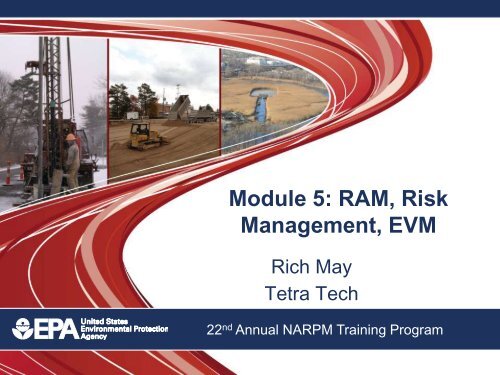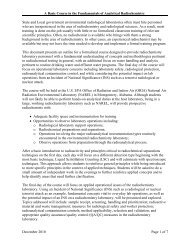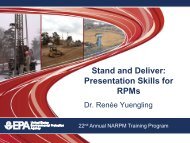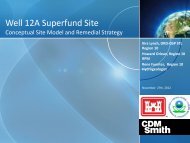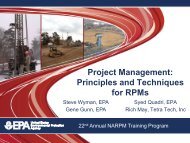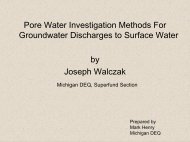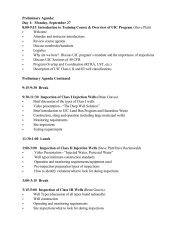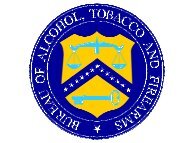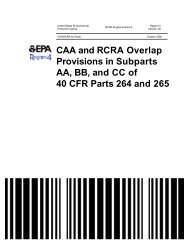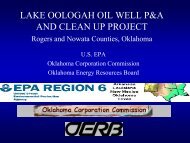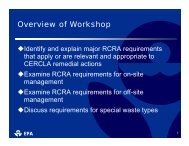Module 5: RAM, Risk Management, EVM
Module 5: RAM, Risk Management, EVM
Module 5: RAM, Risk Management, EVM
You also want an ePaper? Increase the reach of your titles
YUMPU automatically turns print PDFs into web optimized ePapers that Google loves.
Topics To Be Covered Responsibility Assignment Matrix <strong>Risk</strong> Identification - <strong>Risk</strong> BreakdownStructure <strong>Risk</strong> <strong>Management</strong> - <strong>Risk</strong> Register Earned Value <strong>Management</strong>22 nd Annual NARPM Training Program22 nd Annual NARPM Training Program1
OBSResponsibility Assignment MatrixWBS22 nd Annual NARPM Training Program22 nd Annual NARPM Training Program3
Project <strong>Risk</strong> <strong>Management</strong>While Project <strong>Risk</strong> <strong>Management</strong> requiresassessment of project risks, it is not “<strong>Risk</strong>Assessment” as we know it in theEnvironmental WorldThe goal is to increase the probability andimpact of positive events and reduce theprobability and impact of negative events22 nd Annual NARPM Training Program22 nd Annual NARPM Training Program4
Project <strong>Risk</strong> <strong>Management</strong> <strong>Risk</strong> <strong>Management</strong> Planning <strong>Risk</strong> Identification Qualitative <strong>Risk</strong> Analysis Quantitative <strong>Risk</strong> Analysis <strong>Risk</strong> Response Planning <strong>Risk</strong> Monitoring and Control22 nd Annual NARPM Training Program22 nd Annual NARPM Training Program5
<strong>Risk</strong> <strong>Management</strong> PlanningDecide how to approach, plan,and execute risk managementactivities for your project22 nd Annual NARPM Training Program22 nd Annual NARPM Training Program6
<strong>Risk</strong> IdentificationDetermine which risk might affectthe project and document theircharacteristics…”things that go bump in the night”22 nd Annual NARPM Training Program22 nd Annual NARPM Training Program7
<strong>Risk</strong> Identification - RBSALL SOURCES OFPROJECT RISKTECHNICALRISKMANAGEMENTRISKCOMMERCIALRISKEXTERNALRISKSCOPEDEFINITIONPROJECTMANAGEMENTCONTRACTTERMSLEGISLATIONESTIMATESORGANIZATIONPROCUREMENTREGULATORYTECHNICALPROCESSESRESOURCINGSUPPLIERS &VENDORSSITE /FACILITIESTECHNOLOGYCOMMUNICATIONSUBCONTRACTORSENVIRONMENTAL/ WEATHER22 nd Annual NARPM Training Program22 nd Annual NARPM Training Program8
Well 12A Superfund Site RBSWell 12A Superfund Site<strong>Risk</strong> Breakdown StructureTechnical External Internal - Organizational Internal - Project ExecutionDesign/Engineering Regulatory/Permitting Procurement/Funding Project Controls21-USACE VE Study22-Deep Upper Aquifer Data Gaps45-State Superfund Contract46-Future Acceptance of TIWaiver26-Overall ProcurementStrategy27-Uncertain RA FundingProfile34-Successful In-Situ ThermalPerformance35-Successful EAB Performance23-Mass Flux Measurement24-Design Errors25-Design Delay47-Permit Requirements48-Future Acceptance of MNA28-Uncertain RD InvestigationFunding Profile29-Subcontract Terms &Conditions30-Subcontractor Bonding36-Excavation PerformanceCriteria37-Level of Cost EstimateDevelopment38-Level of ScheduleDevelopmentConstruction/OperationsCommunity/Stakeholder31-Subcontractor Insurance32-Bid Results39-Tacoma Power Requirementsfor Infrastructure40-USACE Requirements for VEStudy1-Political Uncertainty 33-Set Aside Requirements 41-Limited Number of Bidders2-Disposal of Excavated Materials3-Excavation Quantities4-Drilling Access Under Buildings5-In-Situ Thermal Treatment VolumesUnder Buildings6-Data <strong>Management</strong>7-Vapor ControlReal Estate/Site Access42-Site Access43-Well 12A Impact on EAB44-Proximity to Railroad Tracks22 nd Annual NARPM Training Program22 nd Annual NARPM Training Program9
Impact543Project <strong>Risk</strong> <strong>Management</strong><strong>Risk</strong> Matrix<strong>Risk</strong> MatrixImpactRatingImpact Category1 Negligible2 Marginal3 Significant4 Critical5 Unacceptable/Crisis211 2 3 4 5ProbabilityProbabilityRatingProbability Category1 Very Unlikely2 Unlikely3 Moderately Likely4 Likely5 Very Likely22 nd Annual NARPM Training Program22 nd Annual NARPM Training Program11
Project <strong>Risk</strong> <strong>Management</strong>Quantitative <strong>Risk</strong> AnalysisNumerically analyze the impact on overallproject objectives22 nd Annual NARPM Training Program22 nd Annual NARPM Training Program12
Project <strong>Risk</strong> <strong>Management</strong><strong>Risk</strong> Response PlanningDevelop options and actions to reduce threatsdue to risk to the project objectives22 nd Annual NARPM Training Program22 nd Annual NARPM Training Program13
Project <strong>Risk</strong> <strong>Management</strong><strong>Risk</strong> Monitoring and Control Track identified risks Identify new risks Execute response plans Evaluate effectiveness22 nd Annual NARPM Training Program22 nd Annual NARPM Training Program14
Earned Value <strong>Management</strong> Methodologyto integrate themanagementof:• Scope• Schedule• CostPlanControlExecute22 nd Annual NARPM Training Program22 nd Annual NARPM Training Program15
Establish the BaselineEstablish aPerformance Measurement Baseline(PMB) Decompose the work scope (WBS) Assign management responsibility (one owner) Develop a time-phased budget for each task Select EV measurement techniques for all tasks Maintain integrity of PMB throughout the project22 nd Annual NARPM Training Program22 nd Annual NARPM Training Program16
Performance MeasurementMeasure project performanceagainst the baseline Record resource usage (Cost) during projectexecution Objectively measure physical work progress Credit EV according to EV techniques Analyze and forecast cost/scheduleperformance Report performance problems and/or takeaction22 nd Annual NARPM Training Program22 nd Annual NARPM Training Program17
Basic <strong>EVM</strong> ElementsEarned Value <strong>Management</strong> (<strong>EVM</strong>) relieson three key data points:• Planned Value• Earned Value• Actual Cost22 nd Annual NARPM Training Program22 nd Annual NARPM Training Program18
Planned Value Developed from the baseline budget and thebaseline schedule…adds TIME to the budget Performance Measurement Baseline (BMB) Budgeted Cost of Work Scheduled (BCWS) Becomes the Yardstick by which the projectis measured Changes to baseline can only be made viaScope Change22 nd Annual NARPM Training Program22 nd Annual NARPM Training Program19
COST (Dollars)$600KPlanned Value$500K$400K$300K$200KPLANNED VALUE$100K1 2 3 4 5 6 7 8 9TIME (Months)22 nd Annual NARPM Training Program22 nd Annual NARPM Training Program20
Earned Value A snapshot of the work progress at a giventime The sum of the value of all completed tasks,plus – The percentage of completion of in-progresstasks Requires an objective method of determiningpercent complete Budgeted Cost of Work Performed (BCWP)22 nd Annual NARPM Training Program22 nd Annual NARPM Training Program21
EV Measurement Techniques Fixed Formula• 50/50, 0/100, 25/75 WeightedMilestone• Divide task intosegments and giveeach a weight Apportioned Effort• Usually for supporttasks Level of Effort• No tangibleoutcome can bemeasured Percent Complete• Most Common• Each uncompleted task isevaluated and acompletion percentage isassigned• Multiply the percentcomplete by the baselinevalue of the task• Sum the values of all tasks22 nd Annual NARPM Training Program22 nd Annual NARPM Training Program22
COST (Dollars)$600KEarned Value$500K$400K$300K$200K$100KPLANNED VALUEEARNED VALUE1 2 3 4 5 6 7 8 9TIME (Months)22 nd Annual NARPM Training Program22 nd Annual NARPM Training Program23
Actual Cost Inception to Date project costs All captured costs, for all tasks for:• Labor• Subcontractors• Other Direct Costs (ODC) Costs should be relatable to activities in theWBS Actual Cost of Work Performed (ACWP)22 nd Annual NARPM Training Program22 nd Annual NARPM Training Program24
COST (Dollars)$600KActual Cost$500K$400K$300K$200K$100KPLANNED VALUEEARNED VALUEACTUAL COST1 2 3 4 5 6 7 8 9TIME (Months)22 nd Annual NARPM Training Program22 nd Annual NARPM Training Program25
So what are we looking for?Variances Schedule Variance (SV) Cost Variance (CV) Variance at Completion (VAC)Since we are concerned with Earned Value,Variances are usually calculated in Dollars(sometimes labor hours or percentages)22 nd Annual NARPM Training Program22 nd Annual NARPM Training Program26
Schedule Variance (SV) Describes the difference between the workyou have actually achieved and the workyou planned to achieve Earned Value minus Planned Value SV = BCWP - BCWS A Negative number is behind schedule A Positive number is ahead of schedule22 nd Annual NARPM Training Program22 nd Annual NARPM Training Program27
COST (Dollars)$600KSchedule Variance$500K$400KPLANNED VALUEEARNED VALUEACTUAL COSTSCHEDULEVARIANCE$300K$200K$100K1 2 3 4 5 6 7 8 9TIME (Months)22 nd Annual NARPM Training Program22 nd Annual NARPM Training Program28
Cost Variance (CV) Describes the difference between the cost ofwork you have incurred and the value of thework you have achieved Earned Value minus Actual Cost CV = BCWP - ACWP A Negative number is over budget A Positive number is under budget22 nd Annual NARPM Training Program22 nd Annual NARPM Training Program29
COST (Dollars)$600K$500K$400KCost VariancePLANNED VALUEEARNED VALUEACTUAL COSTCOSTVARIANCE$300K$200K$100K1 2 3 4 5 6 7 8 9TIME (Months)22 nd Annual NARPM Training Program22 nd Annual NARPM Training Program30
Variance At Completion (VAC) Describes the difference between the totalbudgeted cost of the project and the cost ofthe project at completion Budget at Completion minus Estimate atCompletion VAC = BAC - EAC A Negative number is a budget overrun A Positive number is a budget underrun22 nd Annual NARPM Training Program22 nd Annual NARPM Training Program31
COST (Dollars)$700K$600K$500K$400KVariance At CompletionPLANNED VALUEEARNED VALUEACTUAL COSTETCVAC$300K$200K$100K1 2 3 4 5 6 7 8 9TIME (Months)22 nd Annual NARPM Training Program22 nd Annual NARPM Training Program32


